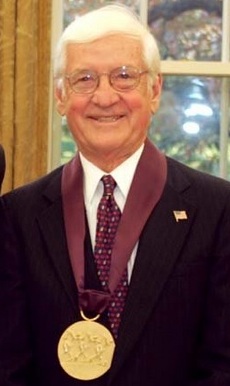
The Federal Duck Stamp, formally known as the Migratory Bird Hunting and Conservation Stamp, is an adhesive stamp issued by the United States federal government that must be purchased prior to hunting for migratory waterfowl such as ducks and geese. It is also used to gain entrance to National Wildlife Refuges that normally charge for admission. It is widely seen as a collectable and a means to raise funds for wetland conservation, with 98% of the proceeds of each sale going to the Migratory Bird Conservation Fund.

Jay Norwood Darling, better known as Ding Darling, was an American cartoonist who won two Pulitzer Prizes. He was an important figure in the 20th century conservation movement and founded the National Wildlife Federation. In addition, he was known to be close friends with Walt Disney.
Peter Murray Hautman is an American author best known for his novels for young adults. One of them, Godless, won the 2004 National Book Award for Young People's Literature. The National Book Foundation summary is, "A teenage boy decides to invent a new religion with a new god."

Waterfowl hunting is the practice of hunting aquatic birds such as ducks, geese and other waterfowls or shorebirds for food and sport.

The National Wildlife Refuge System in the United States has a long and distinguished history.

John Aldrich Ruthven was an American artist best known for his paintings of wildlife.
Terry Avon Redlin was an American artist popular for painting outdoor themes and wildlife, often pictured in twilight. During the 1990s he was frequently named "America's most popular artist" in annual gallery surveys conducted by U.S. Art magazine.

Sherburne National Wildlife Refuge is a National Wildlife Refuge of the United States in Sherburne County, Minnesota. The 30,700-acre (124 km2) refuge protects mixed habitat types including oak savanna, Big Woods, and wetlands. The St. Francis River flows through the eastern side of the park. Over 230 species of birds, 58 species of mammals, and 25 species of reptiles and amphibians have been recorded in the refuge.
Joseph Hautman is an American painter, residing in Plymouth, Minnesota. The artist is best known for his realism wildlife art, particularly the U.S. Federal Duck Stamp. The artist holds a Ph.D. in physics from the University of Michigan and has had his artwork featured on the 2016, 2012, 2008, 2002, and 1992 Federal Duck Stamps, raising millions for conservation.
Jim Hautman is an American painter, residing in Minnesota. The artist is best known for his realist wildlife art, particularly the U.S. Federal Duck Stamp. The artist's paintings have been featured on the 1999, 1995 and 1990 Federal Duck Stamps, a project that raised millions of dollars for environmental conservation.
Daniel Smith is an American painter who resides in Bozeman, Montana. He is known best for his realistic wildlife portrayals.
Karen Latham is an American painter, residing in Hastings, Minnesota. Latham is most known for her realistic miniature paintings of wildlife. Latham is the mother of Bonnie and Rebecca Latham, also painters in the same style.
Maynard Fred Reece was an American artist based in Iowa whose work focused on wildlife, particularly ducks. He won the Federal Duck Stamp competition a record five times in his life: 1948, 1951, 1959, 1969 and 1971. Reece turned 100 in April 2020 and died in July that year.
The Wetlands Loan Act of 1961 became Public Law (P.L.) 87-383 on October 4, 1961. The law allowed an advance against future earnings from the sale of Federal Duck Stamps. This allowed a means of accelerated funding for the acquisition of migratory waterfowl habitats.

Jackson Miles Abbott was an American Lieutenant Colonel in the United States Army Corps of Engineers, a birdwatcher and painter. He was the son of wildlife artist Jacob Bates Abbott. He is the only artist to ever place both first and second in the same year in the Federal Duck Stamp contest. The Jackson Miles Abbott Wetland Refuge at Fort Belvoir in Fairfax, Virginia was named in his honor.

The Permanent Electronic Duck Stamp Act of 2013 is a bill that was introduced into the United States House of Representatives during the 113th United States Congress. The bill would authorize the United States Department of the Interior to issue electronic duck stamps as a form of Federal Duck Stamps.
Leslie Carl Kouba, also known as Les Kouba, was an American artist, author, outdoorsman, and businessman. He specialized in waterfowl paintings but is also known for his early sculpture of Dakota chief Little Crow, which was commissioned by the city of Hutchinson, Minnesota and installed in 1937 at a site overlooking the Crow River. In 1947, he invented the Art-O-Graph, a projector used to transfer a photo to layout. In 1982 he helped produce a new statue for this site, as the first had become weather beaten.
Walter Alois Weber was an American mammalogist, animal artist, and illustrator for National Geographic. He was noted for his colorful and realistic-looking sketches and paintings of animals, particularly wild cats, Alaska Peninsula brown bears, American black bears, coyotes, and dog breeds, including retrievers, hounds, and sporting dogs. He also painted portraits of many other birds, mammals, and reptiles. His work in National Geographic caught the public's attention from 1939 to 1968. In 1967, he was given the Conservation Service Award.

Patrick Ching (born c. 1963) is a Hawaiian conservationist and wildlife artist, ornithological illustrator, and author of children's books.
The Million Dollar Duck is a 2016 documentary film directed by Brian Davis. The film follows participants in the Federal Duck Stamp contest as they create and submit work, as well as exploring the wider history and culture of the competition.








